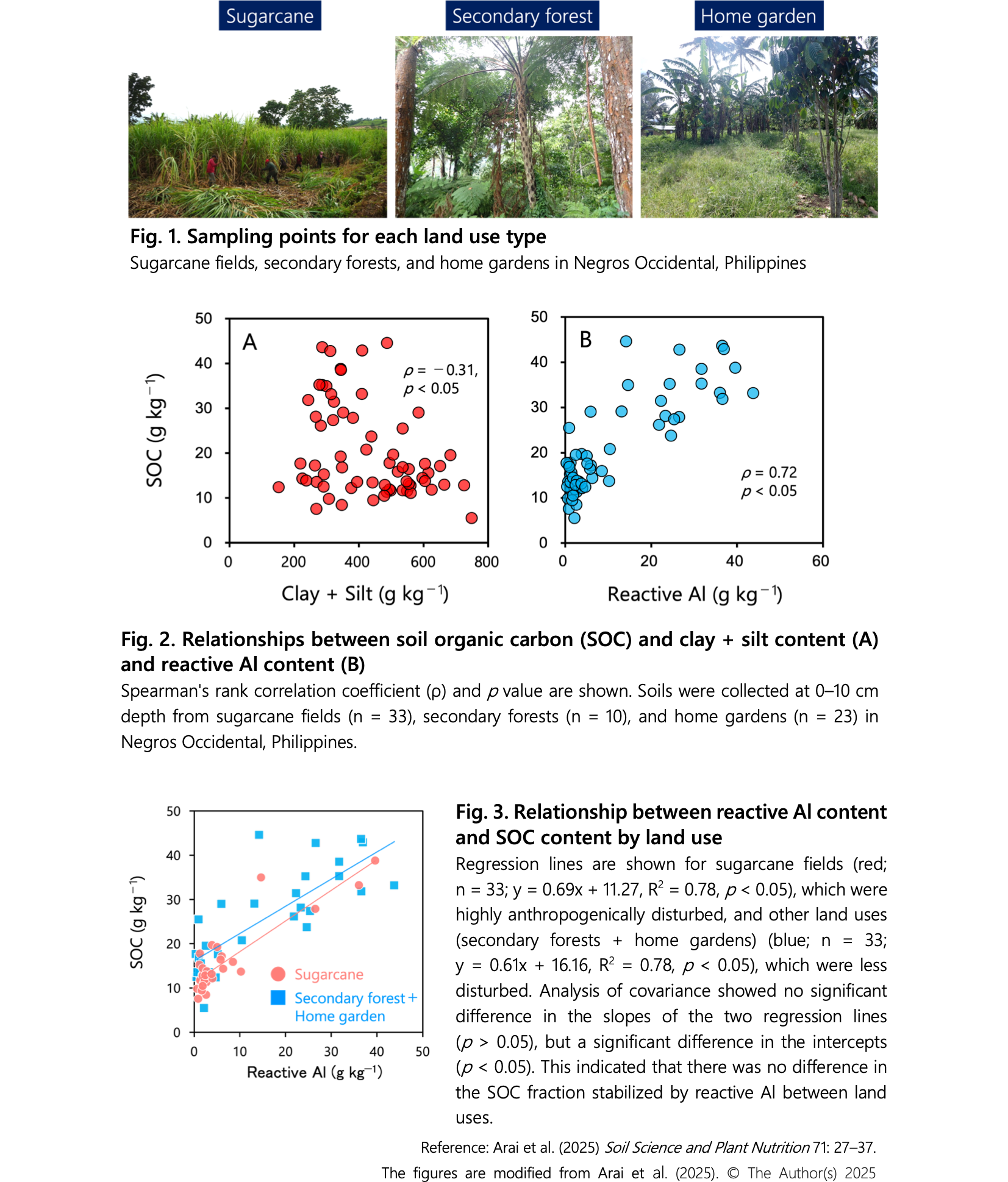Stabilization of soil organic matter by reactive aluminum phases in agricultural fields under volcanic influence
Description
Increasing soil organic matter (SOM) storage in agricultural soils is needed to mitigate climate change and improve soil fertility. Particularly in humid tropical regions, high temperatures and high soil moisture can reduce SOM content. Understanding the factors that control SOM storage is a key step towards effective soil management for sustainable crop production. While clay + silt content is known to be an important factor in the stabilization of soil organic carbon (SOC)*, recent studies have shown that oxalate-extracted Al (reactive Al) is of greater importance. Reactive Al roughly corresponds to organo-Al complexes and amorphous clay**, and is formed through weathering of volcanic debris. However, in the tropics, most studies have been conducted on weathered soils with low reactive Al content, and the relationship between reactive Al and SOC content in different land uses has not been fully understood. This study aimed to clarify the factors regulating SOM content in agricultural fields compared to secondary forests or home gardens in Negros Occidental, Philippines. Sugarcane fields have been continuously cultivated for more than 70 years in the study site (Fig. 1).
SOC showed significant positive correlations with reactive Al content, but not with clay + silt content (Fig. 2). The slope of the regression line between SOC and reactive Al was not significantly different between sugarcane and the other two land uses, while the intercept was significantly lower in sugarcane sites (Fig. 3). These results suggest that land use conversion from forest to sugarcane decreases the SOC fraction (particulate organic matter***) that is relatively easily decomposed by soil microorganisms but does not decrease the SOC fraction stabilized by reactive Al.
Even in humid tropical regions where SOM is easily depleted, it is possible to achieve soil carbon sequestration in agricultural fields by developing technologies to increase the SOC fraction stabilized by reactive Al under volcanic influence. To develop such technologies, it would be necessary to evaluate the effects of factors (e.g., reactive Al content, SOC saturation level, quality and quantity of organic materials applied to fields) on the amount of change in SOC stabilized by reactive Al.
*Stabilization of SOM: resistance to decomposition by soil microorganisms
**Amorphous clay: general term for clay with low crystallinity
***Particulate organic matter: Coarse SOM derived from fallen leaves, dead roots, and dead soil animals
Figure, table
- Research project
- Program name
- Term of research
-
FY2020-2024
- Responsible researcher
-
Arai Miwa ( Crop, Livestock and Environment Division )
ORCID ID0000-0002-5377-7820KAKEN Researcher No.: 20817217Ikazaki Kenta ( Crop, Livestock and Environment Division )
ORCID ID0000-0001-5460-8570KAKEN Researcher No.: 70582021Anzai Toshihiko ( Tropical Agriculture Research Front )
Celestial Perez Virgie ( Sugar Regulatory Administration )
Tumbay Villaflor Jayson ( Sugar Regulatory Administration )
Santillana Salimo Ignacio ( Sugar Regulatory Administration )
Wagai Rota ( Institute for Agro-Environmental Sciences, NARO )
ORCID ID0000-0003-3890-8025KAKEN Researcher No.: 80456748 - ほか
- Publication, etc.
-
Arai et al. (2025) Soil Science and Plant Nutrition.https://doi.org/10.1080/00380768.2024.2415455
- Japanese PDF
-
2024_A03_ja.pdf2.81 MB
- English PDF
-
2024_A03_en.pdf1.37 MB
* Affiliation at the time of implementation of the study.

